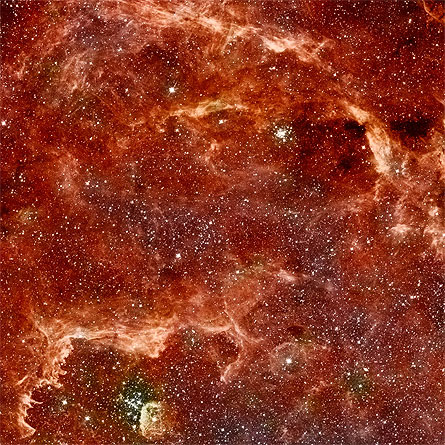LONG BEACH, Calif. — Astronomers have produced the sharpest infrared portrait of the central 300 light-years of the Milky Way, showing details as small as 20 times the length of the solar system.

Seen in visible light, much of the crowded core is cloaked in dust clouds. But infrared light penetrates the dust, providing a clear view of this turbulent region, which houses a supermassive black hole at its very center and lies 26,000 light-years from Earth.
The false-color composite combines ultrasharp images taken at short infrared wavelengths by the Hubble Space Telescope with lower-resolution images taken at longer infrared wavelengths by the Spitzer Space Telescope.
The potrait shows for the first time that most of the young, massive stars at the core are not confined to the three known massive star clusters, as previously thought. Instead, about two-thirds are distributed throughout the central region and could constitute a new class of massive stars, Wang says. Hubble and Spitzer together imaged 600,000 stars in the central region.
The distributed stars either formed in isolation or were ripped out of the clusters by strong gravitational tidal forces from the supermassive black hole, says Q. Daniel Wang of the University of Massachusetts in Amherst. He and his colleagues unveiled the portrait on January 5 at the winter meeting of the American Astronomical Society in Long Beach, Calif.Illuminated shells, bows and tunnels in the image all show the profound impact that massive stars have on their surroundings. Fierce winds and intense ultraviolet light from the massive stars are eroding pillars of dense gas that are the likely birthing sites of stars — and are likely altering the stellar birthing process there. The portrait also reveals, at upper left, that arcs of ionized gas are organized into linear filaments, which may be due to the presence of a strong and highly structured magnetic field at the Milky Way’s center.
One reason astronomers are so interested in star formation at the galactic center is that conditions there are much more extreme — including higher gas temperatures and densities and the strong gravitational field of the supermassive black hole — than in the neighborhood around the solar system, says Andrea Ghez of the University of California, Los Angeles, who was not on the research team.
Most theories of star formation suggest that under these extreme conditions, more massive stars ought to be produced and most of them ought to reside in clusters. Whether or not this trend holds true “is important to understand both as a test of star formation theories but also because conditions in the early universe were also much more extreme than the current universe,” she says. “Understanding a local extreme [in our own galaxy] might provide useful insight into star formation in the distant past,” when galaxies were first born.







